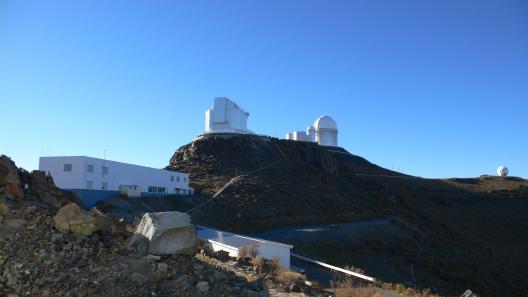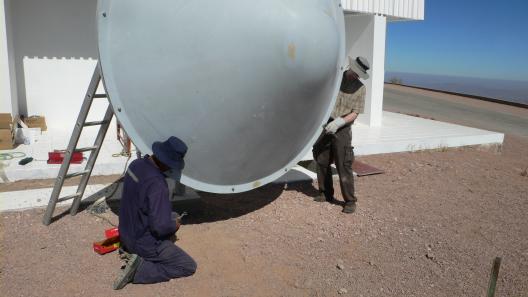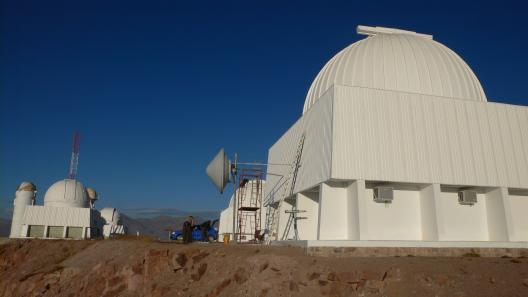
|
|
|
|
May 16, 2009
HPWREN collaborates South of the Equator By James Hale (HPWREN), David Rabinowitz (Yale University), and Sam Leffler (FreeBSD Project) HPWREN participated in Chile in an astronomy-related collaboration with the Yale University Physics Department, and the FreeBSD Project. Just a couple of hours outside La Serena, Chile is the European Southern Observatory at La Silla. This is where Yale's David Rabinowitz has recently installed Yale's QUEST survey camera -- a giant mosaic of 112 CCD sensors -- into the previously retired 1.0-m Schmidt telescope. Formerly located at the 1.2-m Oschin Schmidt telescope at Palomar Observatory in California, a Schmidt telescope gives the QUEST camera an enormous field of view -- close to 10 square degrees. This allows it to survey a large fraction of the night sky and to detect rare "transients", objects that move, like asteroids or comets, but also phenomena that vary in brightness such as supernovae, quasars, and gamma-ray bursts. The camera generates large amounts of data that are best moved quickly to make the timely use by the multiple researchers that analyze the data. At the Palomar Observatory in Southern California, the data is moved across the OC3 backbone of the High Performance Wireless Research and Education Network (HPWREN). Though La Silla does have network connectivity, the burden of moving this quantity of data would be difficult. The nearby Cerro Tololo Inter-American Observatory, on the other hand, has sufficient bandwidth to move large amounts of data generated. But they don't have a Schmidt Telescope and they're 101 kilometers away on another mountaintop. Taking inspiration from the Palomar Observatory, David contacted HPWREN for assistance for setting up a wireless link to Cerro Tololo. The original meeting was between Hans-Werner Braun, David, and James Hale. Hans-Werner was able provide a great deal of technical advice as well as the loaning this project a pair of 5.8GHz radios and two 8-foot solid parabolic antennae, as well as James' assistance as the HPWREN installation coordinator. David then collected up the HPWREN gear and headed back to Yale University, to attack the daunting task of packing up all the equipment and having it transported to Chile. One of the obstacles David ran into was that the 5.8GHz frequency is a licensed band in Chile and a different frequency would be required if the Chilean version of the FCC was to be avoided, as well as the additional fees the government would require. We discovered that 2.4GHz is an unlicensed band in Chile, so the 5.8GHz antennae were retrofitted to the new band by replacing the feeds, while also using different radios. David first searched for a commercial product to handle the link, but came up empty--no vendor was willing to deliver a system that would meet his needs. Then he came across a story about a 271km wireless link setup in Venezuela by the UC Berkeley TIER Project together with the Intel Research Lab at Berkeley. David contacted Kevin Fall of Intel and he assisted with purchase of the radio hardware and an initial buildup. But at the last minute Intel backed out of the trip and instead Sam Leffler of the FreeBSD Project joined us. This turned out to be good luck as Sam is well-known for his work on Open Source 802.11 software and for the last several years has been working with Intel Research on support for long distance wireless links. Sam put together the radios for the link using off-the-shelf components, using Gateworks 2348 (Avila) boards, Ubiquiti XR2 radios, and FreeBSD for the operating system. Though James had communicated with Sam via email, they never met until Sam approached James on a Sunday at the Los Angeles International Airport as we waited for our flight to Santiago. We were to later meet David in Santiago, where we would all catch the same flight to La Serena, then rent a car, and drive to ESO. After meeting up with David in Santiago, we decided that we would not accomplish much on Monday, after our flight to La Serena was delayed by about four hours. We arrived at La Silla with just enough time to get settled into our room and grab a bite to eat. David, Sam and James, along with the assistance of the of the ESO Astro Workshop crew, spent the next 2 days assembling, configuring and installing. At day's end on Wednesday we had the La Silla end of the link aimed and transmitting to Cerro Tololo. Wednesday afternoon we left Sam with the Astro Workshop crew to handle the alignment at his end of the link and David and James left for Cerro Tololo to setup the other end. On Thursday we arrived at the far side to see the antenna at Cerro Tololo assembled and nearly complete, thanks to the help of Cerro Tololo's Eduardo Figuero and Ron Lambert in arranging the construction and the local network connection. David and I quickly got on the air and the link was brought up almost immediately. We talked with Sam at La Silla using Skype and aligned the dishes at each end until we had good signal. With the link tuned, end-to-end bandwidth was better than expected; more than 18Mb/s in each direction for an aggregate 36Mb/s. The work at Cerro Tololo was completed in ample time for us to drive back to La Serena as the sun set. Since the flight home wasn't until Friday afternoon, David took some time to expose James to sites and flavors of Chile. Sam missed out on the tours as he was scheduled to take a bus ride back to the La Serena airport. Sam arrived at the airport just shortly before the plane was to board for Santiago and then home. James was confident from the start we'd have success. He had participated in the installation of quite a few links and this one was not the longest. The TDMA based radios were the biggest difference in the installations he has done in the past. As always, there were obstacles. Based on the tools we had on hand, the link functions better then expected. Continued monitoring will show how the link works in the long run and we all are anxious to see how the link performs for the Quest Project on a long term basis.
|





